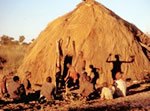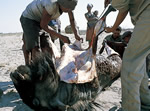Research
The lion as the symbol of the other
From the perspective of the Gwi,
a hunting tribe of the Kalahari Desert

The Gwi bushmen, a hunter-gatherer tribe, have long lived in an area that is now the central Kalahari animal preserve located in the middle of Botswana, in southern Africa. To study their way of life, which to this day retains strong traces of traditional elements, I began living among them in 1982 and conducted a study of their daily communication by observing their activities and analyzing their conversations.

I transcribed the conversations and stories I recorded, and considered the cultural phenomena that were the backdrop to the events.
It is not possible to describe their way of life without discussing their interaction with animals. For them, animals are "others" with a spirit, and they conduct their lives every day by interacting with them. An attack by a lion will disrupt this order, however. Nonetheless, while the Gwi tell stories about the gruesomeness of being killed by lions, they also tell thrilling stories about overcoming the lion at the end of a battle. This is not to exclude the stronger lion from their relationship with animals as an arch-enemy to be shunned. Rather, it indicates an attitude of drawing as close to lions as possible and actively creating a relationship between them. Because the lion is a stronger "other", they learn how to risk their lives when dealing with them. This also creates an awareness of equality with animals, and humility toward nature. There is an interaction between the animals that the Gwi tell stories about and human beings, who lived as hunter-gatherers until about 10,000 years ago. This interaction might well provide us with the opportunity to reexamine the world and our place in it as one part of nature.

Boys and girls dance, enthralled by the shadows on the grass hut. People gathered and talked before that.

About to beat a wildcat, one of the "paaxo", to death.

The carcass of a wildebeest. The meat taken during the hunt is distributed equally to all those at camp.
Born in Tokyo in 1949, Sugawara received a doctorate in science from Kyoto University. He has served as an assistant in the Faculty of Letters at Hokkaido University, an associate professor at the Kyoto University's College of Liberal Arts and Sciences, and both associate professor and professor at the same university's Faculty of Integrated Human Studies. Since 2003 he has been a professor at Kyoto University's Graduate School of Human and Environmental Studies.
- Dialogue:What is RNA? An ageless worker with information and a function
Yoshikazu Nakamura / Keiko Nakamura - Research01:A backstage look at becoming multicellular using cellular slime molds
Hideko Urushihara - Research02:Lions as a symbol of other
Kazuyoshi Sugawara - Scientist Library:Looking at plants, asking plants
Hiroh Shibaoka
|
|